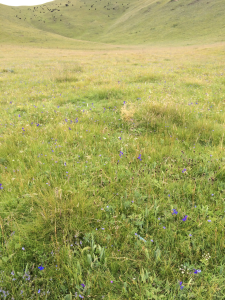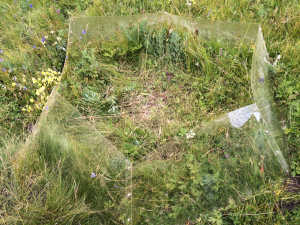
Is biodiversity good for us? In many ways, this is a stupid question because at some point, losing species that we use directly will obviously impact us negatively — think of food crops, pollination and carbon uptake.
But how much can we afford to lose before we notice anything bad is happening? Is the sort of biodiversity erosion we’re seeing today really such a big deal?
One area of research experiencing a surge in popularity is examining how variation in biodiversity (biowealth1) affects the severity of infectious diseases, and it is particularly controversial with respect to the evidence for a direct effect on human pathogens (e.g., see a recent paper here, a critique of it, and a reply).
Controversy surrounding the biodiversity-disease relationship among non-human species is less intense, but there are still arguments about the main mechanisms involved. The amplification hypothesis asserts that a community with more species has a greater pool of potential hosts for pathogens, so pathogens increase as biodiversity increases. On the contrary, the dilution hypothesis asserts that disease prevalence decreases with increasing host species diversity via several possible mechanisms, such as more host species reducing the chance that a given pathogen will ‘encounter’ a suitable host, and that in highly biodiverse communities, an infected individual is less likely to be surrounded by the same species, so the pathogen cannot easily be transmitted to a new host (the so-called transmission interference hypothesis).
So I’ve joined the ecological bandwagon and teamed up yet again with some very clever Chinese collaborators to test these hypotheses in — if I can be so bold to claim — a rather novel and exciting way.

The yak-excluded meadow vegetation at Azi Shi Yan Zhan research station in the Tibetan Plateau. Yes, those little black dots in the upper left are yaks.
You might recall that I have been working with Professor Shurong Zhou and her team for several years looking at variation in ecosystem functions in response to altered biodiversity through a wonderful set of manipulation experiments of meadow vegetation in the Tibetan Plateau (see previous publications arising here and here). Not content to have me merely as an electronic collaborator, Shurong invited me to visit the experimental station high in the Tibetan Plateau in mid-2014. What a wonderful experience that was!
What makes these experimental plots so amazing is that they are (i) highly biodiverse (up to 40 species in a 1×1 m plot), (ii) manipulations of existing communities (removal experiments) and not artificially constructed plantings, and (iii) attended to by an army of dedicated students and technicians.
Many, if not most past studies investigating the role of variable biodiversity in modifying ecosystem functions tend to use the simplest metric of all — species richness — to quantify ‘biodiversity’. But using species richness this way is problematic because it is usually a poor predictor of functional diversity2, which makes getting at the underlying mechanisms tricky.
As a case in point, previous studies have found that the probability of a pathogen infecting two plant species decreases with phylogenetic distance between the two plants. While supportive of the general hypothesis, these studies have tended to confound the potential influence of both host abundance and richness when attempt to clarify the relationship between phylogenetic distance and disease resistance. Another problem is that experimental evidence for these various hypothetical mechanisms has been largely restricted to planting experiments, thus limiting their extension to natural communities.
Luckily for me, my Chinese collaborators have also measured the full phylogenetic diversity of this meadow community, so we could explicitly control for the confounding effects of species richness and abundance in natural (cf. artificial) communities. Our first experiment was to manipulate species richness and phylogenetic diversity by removing specific groups of species in the plots.
The result was rather astounding, because it came out almost exactly the way we expected (how often does that happen in ecology?). We confirmed the dilution effect — greater phylogenetic diversity of the host community reduces the overall incidence of fungal disease, even though there were more pathogens!
But we didn’t stop there.

An open-top chamber surrounding one experimental plot. These increased the temperature at the soil by an average of 1.3 ˚C.
We’re all worried about what global environmental change is doing to ecosystem functions via the loss of species diversity, but how might this affect the biodiversity-disease relationship? Warming could potentially intensify the transmission of pathogens by extending their growth and reproduction frequency, whereas other pathogens might not be ideally suited to higher temperatures or different hydrological (precipitation) regimes.
Artificial manipulation of the soils through fertilisation is another issue that could affect plant pathogens in particular. Some pathogens might be released from nitrogen limitation via the addition of nitrogenous fertilisers, whereas others might suffer the improved immunity of their hosts resulting from a greater availability of nitrogen. Such changes might also indirectly affect disease prevalence and severity by favouring certain host species over others.
Our second experiment was to test the influences of artificial warming and fertilisation on the observed relationships, by placing the plots within small, open-top chambers and/or adding nitrogenous fertiliser, respectively.
Interestingly, both experimental warming and fertilisation increased pathogen loads. The coolest result though was that fertilisation weakened the dampening effect of increasing host diversity, most likely by enhancing fungal spore production, infection success, and lesion growth by the hosts. In fact, we found that the pathogen load of species-rich communities was more sensitive to nitrogen fertilisation than that of species-poor communities. This means that changing the delicate balance of the healthy, intact community by releasing it from nitrogen limitation not only resulted in more pathogens, it weakened the overall community’s resistance to disease.
It is now clear that higher biodiversity (both in terms of total number of species, phylogenetic diversity, as well as species turnover) imparts greater disease resistance, lower invasibility, higher productivity, lower temporal variability in abundance (i.e., reduced extinction risk), and better pollination (in the case of plants). If you need more evidence that maintaining biodiversity is essential, I’m not sure what else might convince you.
CJA Bradshaw (森林洞人老师)
1In this case, I strongly advocate using the term biowealth because the benefits of having higher biodiversity are immediately obvious.
2It turns out that most direct measures of functional diversity are also problematic because they do not actually measure functional diversity that well.

